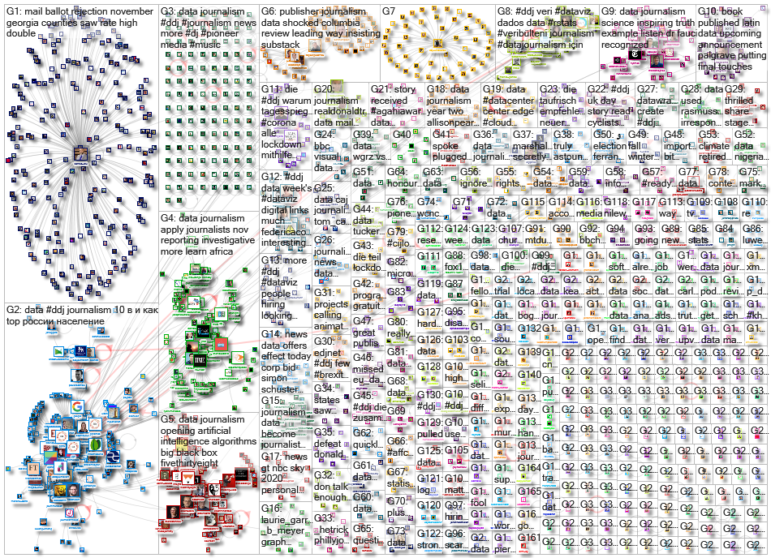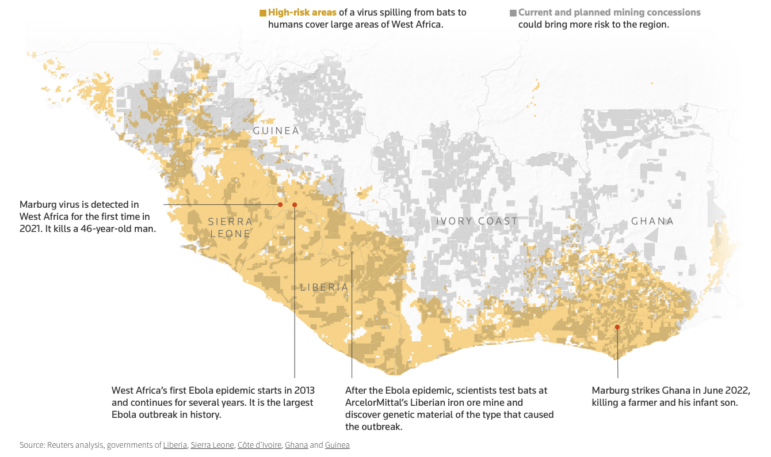

Data Journalism Top 10: Thanksgiving Dangers, Vaccine Tracker, Crosswords Diversity, Golf Swings, Facebook Fact-checks
Read this article in
Around the world, people are toning down their celebrations in a bid to mitigate spread of the coronavirus. The latest casualty: Thanksgiving. Our NodeXL #ddj mapping from November 16 to 22 found FiveThirtyEight’s timely piece explaining the risk of COVID-19 transmission from even small Thanksgiving dinner gatherings. Also popular: The New York Times tracking the status of all vaccine trials in progress, and The Pudding analysis of race and gender in crossword puzzles from five major US news publications.
A Pandemic Thanksgiving
Planning to have Thanksgiving with family members from another household? Read this story by FiveThirtyEight first. By illustrating the risk of COVID-19 transmission across dozens of dinner parties, senior science writer Maggie Koerth and visual journalist Elena Mejía show how even small Thanksgiving gatherings outside your household bubble can be a real threat in spreading the coronavirus. Here’s another take on Thanksgiving dinners by columnist Farhad Manjoo for The New York Times, in which he estimates his “COVID-19 bubble” by tracing his closest contacts and the people they come into contact with. Manjoo found that his bubble was surprisingly enormous.
COVID-19 Vaccine Tracker
Scientists around the world are racing to produce a safe vaccine for COVID-19, with more than 50 vaccines currently in clinical trials on humans. Overwhelmed by the deluge of vaccine news? The New York Times briefly explains the development cycle of a vaccine, from lab to final distribution. It is also tracking in one place the status of all vaccines that have reached trials in humans, together with a selection of promising vaccines still being tested in animals. For more on vaccine development, check GIJN’s Health Guide.
Diversity in Crossword Puzzles
Are crossword puzzles in major US news publications too old, too white, and too male? Michelle McGhee finds out by analyzing the representation of race and gender in crossword answers over several decades from The New York Times, Los Angeles Times, The Wall Street Journal, Universal, and USA Today. She discovered that USA Today is the one publication that actually over-represents historically underrepresented groups.
Sustainable Development Goals
Confused about the World Bank’s Sustainable Development Goals and what the institution is trying to achieve? A large team of collaborators including several data visualization designers have created an atlas filled with interactive charts and maps that explains and highlights trends for selected targets within each goal, introduces concepts about how SDGs are measured, and discusses COVID-19’s impact on some goals.
Revolutionizing Golf Swings
How does golf pro Bryson DeChambeau manage to hit 15 yards farther than his closest competitors do? It all comes down to technique. The Economist analyzed data from ShotLink, including how fast a golfer swings (clubhead speed), the ball’s trajectory (launch angle), and its rotation speed (spin rate). The Economist built a statistical model to predict driving distances of notable professional golfers. The three factors combined explain 70% of the differences between players’ distances.
The Kids Aren’t Alright
The Financial Times conducted a global survey of more than 800 young people on their experiences during the pandemic. The data revealed that even though this age group is less at risk of developing severe cases of COVID-19, they are suffering from the pandemic’s economic fallout more harshly than other age groups. Many were most concerned with employment, disposable income, education, and mental health.
Facebook’s Fact-Checking
How effective and efficient is Facebook’s fact-checking labeling system? The Tow Center for Digital Journalism reviewed fact-checking labels on Facebook between October 1 and 5 and found that the social media company failed to consistently label content flagged by its own third-party partners. Over 70 claims had been debunked, but less than half of over 1,100 posts across Facebook and Instagram containing the debunked falsehoods bore fact-checking labels.
Own Your Newsfeed
As journalists, it is difficult to keep up with so many sources of news, information, and data everyday. Journalist and analyst George Anadiotis suggests tools and strategies that will help you follow and keep track of sources of information with a structured approach.
Reporting on AI and Algorithms
Algorithms, big data, and artificial intelligence are complex topics to navigate and report on. But as they become more mainstream, journalists are increasingly needed to make sense of these systems and explain them to readers. At the recent UK-based Centre for Investigative Journalism’s Logan Symposium, April Glaser, Cory Doctorow, Jack Poulson and Tim Maughan shared tips on covering these technologies. Watch the full session here.
Upcoming Book: Data Journalism in Latin America
Ramón Salaverría and Mathias-Felipe de-Lima-Santos, both researchers at the University of Navarra, Spain, are working on a book on how digital and data journalism have shaped the news industry in Latin America. The book, slated to be published in 2021, explores innovative approaches in news production, circulation, and distribution in digital and data journalism.
Thanks again to Marc Smith and Harald Meier of Connected Action for gathering the links and graphing them. The Top Ten #ddj list is curated weekly.
 Eunice Au is GIJN’s program manager. Previously, she was a Malaysia correspondent for Singapore’s The Straits Times, and a journalist at the New Straits Times. She has also written for The Sun, Malaysian Today, and Madam Chair.
Eunice Au is GIJN’s program manager. Previously, she was a Malaysia correspondent for Singapore’s The Straits Times, and a journalist at the New Straits Times. She has also written for The Sun, Malaysian Today, and Madam Chair.










